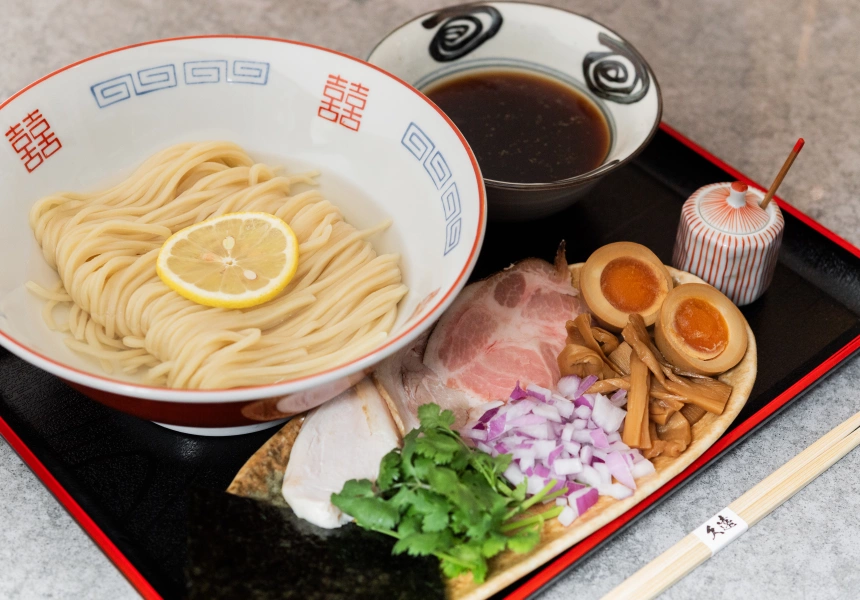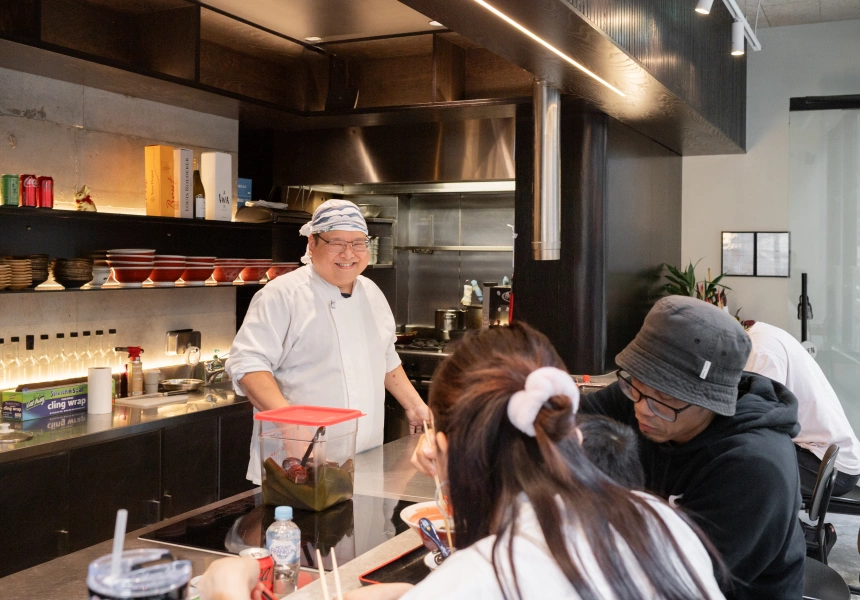“We like tonkotsu ramen, but it gives us gout,” Kuon’s co-owner Kenny Lee tells Broadsheet, laughing. Lee owns the hospitality group – behind Kuon Omakase and the now-closed Tempura Kuon – with chef Hideaki Fukada. And when they were tasked with opening another intimate omakase restaurant, the brief went in a different, more casual direction. Enter Kombu Lab, a 10-seat ramen bar with a teeny menu.
“We decided to come up with a light-flavoured [broth], but at the same time, using great ingredients with the customer being able to taste each of the ingredients,” Lee continues. What did they land on? Kelp.
The pair have nailed a four-part menu – two types of ramen and two bowls of tsukemen (Japanese dipping noodles) – using only delicate kombu broths, without missing a lick of flavour.
Stay in the know with our free newsletter. The latest restaurants, must-see exhibitions, style trends, travel spots and more – curated by those who know.
SIGN UPIn a city where pork-powered tonkotsu is seemingly king, they’re shaking it up.
There are two of the kelp broths available: shio and shoyu. Both are simmered for eight hours, because executive chef Fukada wouldn’t stand for a cloudy soup. The shio is elegant and clean, made with a blend of ocean salt and pink Himalayan salt flakes. While the shoyu is made with yuki shoyu, a style from Saitama prefecture that imparts an extra dimension of sweet and savoury.
Whichever you choose, the broths are all for the betterment of takasuimen noodles, a high-hydration style a supplier makes for the team especially, using Kiwi Champion flour. The noodles have a smooth and chewy texture called “mochi mochi”, and arrive thin for the ramen (because they absorb soup better) and thicker for the tsukemen.
Kombu Lab’s signature tsukemen is a fresh take on a classic. But don’t expect a more intense broth, it’s the same as the one served with the ramen – “tsukemen is more about the noodle,” Lee says. When you get your bowl, you’re directed to sprinkle a little ocean salt onto a noodle, to taste, before sending them into your choice of soup. The salt enhances the flavour of the noodles, which are ladled with kombu water beforehand for an extra punch of umami. When you’re out of noodles, mix the dipping broth with the kombu water and slurp.
A range of toppings and eight-hour sous-vide meats join every tsukemen. Each set comes with bamboo shoots, shallots, nori, red onion, coriander and pork chashu. Then if you opt for a zenbu bowl you’ll also receive an ajitama egg (a soft-boiled egg marinated in soy sauce), pork neck and chicken chashu marinated with yuki shoyu, and a torched Hokkaido scallop or house-made prawn wonton. The red onion and coriander aren’t common toppings but they pair well with the broth.
When it comes to ramen, it’s the same options in a different format.
There’s no place like Kombu Lab in Sydney, and it’s a big risk opening a 10-seater at Circular Quay. The eatery is only open for lunch and dinner on weekdays, tapping into the crowds of city workers. For now it’s a pop-up, running for between three and six months, but if it proves popular it could stick around.
The venue has quietly opened, and serves around 40 bowls each service (with a max of 50). “We’re getting a great response from our guests,” Lee says. “We’re pretty confident because we already got a few people coming back.”
With the lighter, umami-forward broths highlighting each ingredient, you can count on this Broadsheet writer being one of them.
Kombu Lab
4 Loftus Lane, Sydney
Hours:
Mon to Fri 11.30am–2.30pm, 5pm–7.30pm
Additional reporting by Grace MacKenzie.



